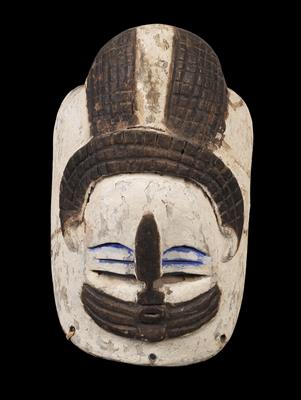Bini, Nigeria: a typical mask of the Bini people, who live around the well-known royal city of Benin, in Nigeria.
Bini, Nigeria: a typical mask of the Bini people, who live around the well-known royal city of Benin, in Nigeria.

The Bini are the ‘rural population’, as it were, of the well-known Kingdom of Benin. They live around the city of Benin in Southwest Nigeria, west of the Niger river. Their ‘rural’ culture has little to do with the court culture of the city-kingdom of Benin (with their world famous bronze heads, ivory works etc.). The culture, religion and the social life of the Bini people primarily revolves around their ‘Ekpo cult’, within which ritual ceremonies and mask dances are performed. The masks for these dances have their own style, which is noticeably different from that of their larger neighbours, the Yoruba. The present mask is typical for the distinct style of the Bini people: the striking flat, wide face is, together with the rim and parts of the hairstyle, coloured in white with kaolin. The offset eyebrows, as well as the eyes – which are thin slits and merely sketched – are accentuated in blue (‘bluing’). The actual slits for the eyes of the masked dancer lie below the blue eyes, next to the unconventionally formed, flat nose, that is dyed dark brown, as are also the small mouth, the chin and both sides of the beard. Above the white forehead protrudes a three-row ‘diadem’ formed from rectangles, carved in relief and also of dark brown colour. These brown rows of rectangles extend into two wide strands within the tall protuberant hairstyle. The rows of rectangles should represent ornamental chains, made from glass pearls or other materials. Here we come full circle to the formal stylistic court art of the Benin Kingdom: the tall collars, caps and shirts formed from strands of red coral, that the queen (‘Oba’) of Benin once wore and can be seen on the famous bronze heads. This rare Bini mask is a highly interesting historical-cultural object and is in excellent condition. It has a noticeable usage patina, especially on the inside – the smooth areas are exactly where they should be, namely where the nose, forehead and cheeks of the dancer rubbed against the shiny wood. There is no noteworthy damage. Height: 31 cm; width: c. 18 cm. First half of the 20th century. (ME)
Provenance:
Austrian private collection.
Lit.:
'Encyclopedia of African Art and Culture' by K.-F. Schädler, ill. p. 105.
Esperto: Prof. Erwin Melchardt
 Prof. Erwin Melchardt
Prof. Erwin Melchardt
+43-1-515 60-465
erwin.melchardt@dorotheum.at
09.06.2016 - 17:00
- Prezzo realizzato: **
-
EUR 1.500,-
- Prezzo di partenza:
-
EUR 600,-
Bini, Nigeria: a typical mask of the Bini people, who live around the well-known royal city of Benin, in Nigeria.
The Bini are the ‘rural population’, as it were, of the well-known Kingdom of Benin. They live around the city of Benin in Southwest Nigeria, west of the Niger river. Their ‘rural’ culture has little to do with the court culture of the city-kingdom of Benin (with their world famous bronze heads, ivory works etc.). The culture, religion and the social life of the Bini people primarily revolves around their ‘Ekpo cult’, within which ritual ceremonies and mask dances are performed. The masks for these dances have their own style, which is noticeably different from that of their larger neighbours, the Yoruba. The present mask is typical for the distinct style of the Bini people: the striking flat, wide face is, together with the rim and parts of the hairstyle, coloured in white with kaolin. The offset eyebrows, as well as the eyes – which are thin slits and merely sketched – are accentuated in blue (‘bluing’). The actual slits for the eyes of the masked dancer lie below the blue eyes, next to the unconventionally formed, flat nose, that is dyed dark brown, as are also the small mouth, the chin and both sides of the beard. Above the white forehead protrudes a three-row ‘diadem’ formed from rectangles, carved in relief and also of dark brown colour. These brown rows of rectangles extend into two wide strands within the tall protuberant hairstyle. The rows of rectangles should represent ornamental chains, made from glass pearls or other materials. Here we come full circle to the formal stylistic court art of the Benin Kingdom: the tall collars, caps and shirts formed from strands of red coral, that the queen (‘Oba’) of Benin once wore and can be seen on the famous bronze heads. This rare Bini mask is a highly interesting historical-cultural object and is in excellent condition. It has a noticeable usage patina, especially on the inside – the smooth areas are exactly where they should be, namely where the nose, forehead and cheeks of the dancer rubbed against the shiny wood. There is no noteworthy damage. Height: 31 cm; width: c. 18 cm. First half of the 20th century. (ME)
Provenance:
Austrian private collection.
Lit.:
'Encyclopedia of African Art and Culture' by K.-F. Schädler, ill. p. 105.
Esperto: Prof. Erwin Melchardt
 Prof. Erwin Melchardt
Prof. Erwin Melchardt
+43-1-515 60-465
erwin.melchardt@dorotheum.at
|
Hotline dell'acquirente
lun-ven: 10.00 - 17.00
kundendienst@dorotheum.at +43 1 515 60 200 |
| Asta: | Tribal Art - Africa |
| Tipo d'asta: | Asta in sala |
| Data: | 09.06.2016 - 17:00 |
| Luogo dell'asta: | Wien | Palais Dorotheum |
| Esposizione: | 04.06. - 09.06.2016 |
** Prezzo d’acquisto comprensivo dei diritti d’asta acquirente e IVA
Non è più possibile effettuare un ordine di acquisto su Internet. L'asta è in preparazione o è già stata eseguita.
